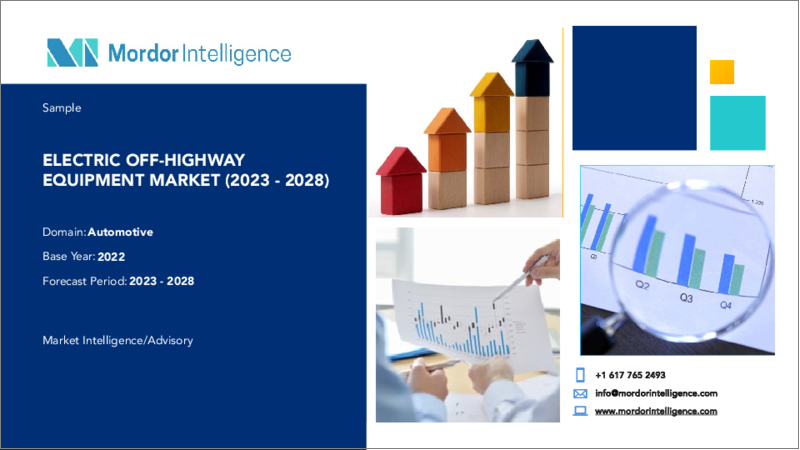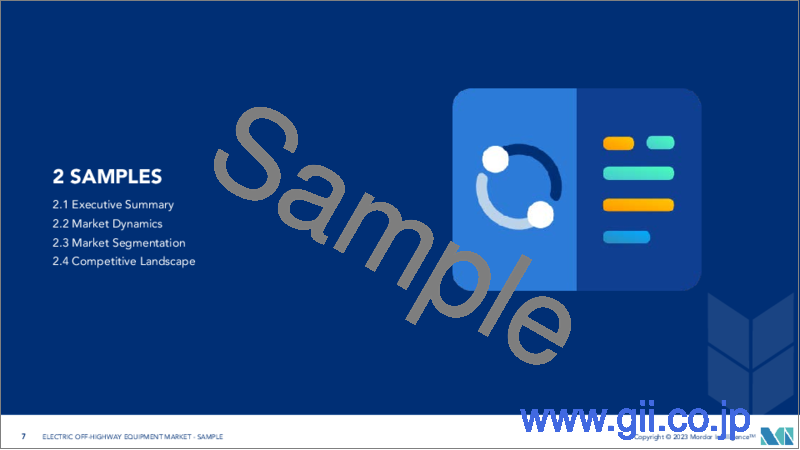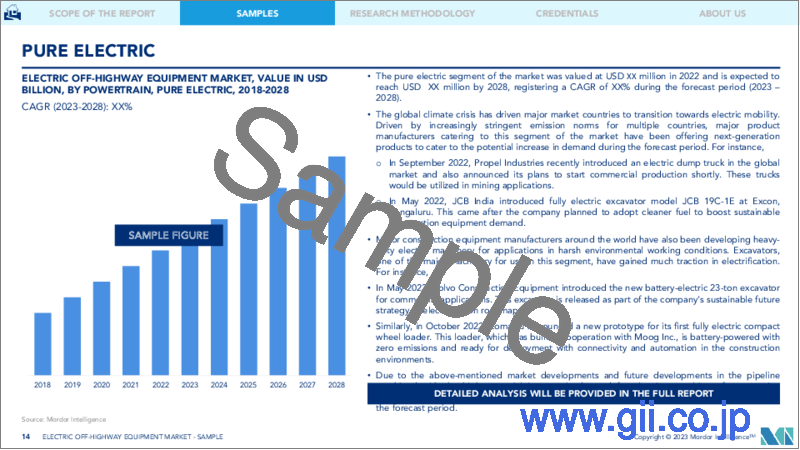|
|
市場調査レポート
商品コード
1137917
電動オフハイウェイ機器/機械市場- 成長、動向、予測(2022年-2027年)Electric Off-highway Equipment/Machinery Market - Growth, Trends, and Forecasts (2022 - 2027) |
||||||
|
● お客様のご希望に応じて、既存データの加工や未掲載情報(例:国別セグメント)の追加などの対応が可能です。 詳細はお問い合わせください。 |
|||||||
| 電動オフハイウェイ機器/機械市場- 成長、動向、予測(2022年-2027年) |
|
出版日: 2022年10月13日
発行: Mordor Intelligence
ページ情報: 英文 90 Pages
納期: 2~3営業日
|
- 全表示
- 概要
- 目次
電動オフハイウェイ機器/機械市場は、2021年に104億9000万米ドルと評価され、2027年末には175億米ドルの純評価額を超え、予測期間中に8.76%の堅実なCAGR成長を記録すると予測されています。
COVID-19の大流行により、2020年には建設や鉱業など世界中の多くの産業が投資の低迷を目の当たりにしました。これは、感染拡大を抑制するために政府の厳しい措置が取られた後のことです。また、世界の封鎖措置により、建設業界は全体的な処理能力の低下を示し、最終的に電動オフハイウェイ機器/機械の需要に影響を及ぼしました。
さらに、COVID-19以降、2021年は転換期とされ、道路、鉱山、インフラなどの投資と複数の建設プロジェクトの増加により、2022年に成長が見込まれます。
電動オフハイウェイ車は、高い総合効率、高い操縦性、運転中の正確さなど、さまざまな利点を備えています。オフハイウェイ車の電動化には多くの利点がありますが、バッテリーの蓄電容量に限界があるなど、さまざまな技術的要因があるため、業界での採用は遅々としたペースになると予想されます。
電気推進オフハイウェイ車の欠点により、現在ではハイブリッドオフハイウェイ車の使用が有力な選択肢と考えられていますが、ハイブリッドオフハイウェイ車市場の成長は高い開発コストに阻まれています。建設機械や鉱山機械などのオフハイウェイ車のパワートレインの電動化は、従来のディーゼルエンジン搭載の機械から発生する排気ガスや騒音への懸念から、注目されています。
アジア太平洋地域は、今後も電動オフハイウェイ機器の需要の中心であり続けると予想されます。これは、大規模な建設、採掘、インフラ開発プロジェクトがこの地域で進行中であることに起因しています。また、この地域の主要企業は、技術革新と優れた性能を融合させるために、研究開発費を飛躍的に増やしています。最終市場からは、高性能・高効率で安全なハンドリング機器が求められており、予測期間中の市場競争はさらに激化すると予想されます。
主な市場動向
ハイブリッド型オフハイウェイ機器/機械が最高の市場シェアを占める
世界的に増加する二酸化炭素排出量と気候変動は、主要先進国および発展途上国の政府機関にとって潜在的な課題となっています。運輸部門は温室効果に大きく寄与しており、世界の二酸化炭素排出量の約24%を占めています。運輸部門から排出される二酸化炭素を最小限に抑えるためには、低炭素化技術やゼロエミッション技術を大規模に展開することが必要です。
代替燃料車(AFV)は、ゼロ・カーボン・エミッション技術に関連して、エネルギー的に持続可能な輸送手段を提供し、この問題に対処するための潜在的な革新技術として注目されています。世界各国の政府による厳しい排出規制の導入に伴い、ハイブリッド型オフハイウェイ機器/機械の需要が高まり、メーカーによる環境対応型機械の発売をさらに後押ししています。
オフハイウェイ機器/機械は、推進システムにハイブリッドエンジン(すなわち、ディーゼル電気)を採用することが主流となっています。これらのディーゼル電気ハイブリッドドライブシステムは、少し小さめのエンジンで低回転での走行を可能にします。これは、燃費の節約、部品点数の削減、エンジンの長寿命化につながります。持続可能性の他に、ハイブリッドエンジンを使用する利点として、車両騒音の低減が挙げられます。例えば
- 2021年9月、コマツは新しい3シリーズのハイブリッドパワートレイン技術の一部である新しいWE1850-3ホイールローダを発表しました。さらに、このローダーは、メインライン生産とショベルのバックアップに活用できる多用途な積載ツールを提供します。
- 2022年9月、ボルボ建機は、同社の製品の中でも最大級の38トンクラスのEC380Eハイブリッドショベルモデルを発表しました。このモデルにより、同社は一貫してハイブリッドレンジを拡大し、燃費を17%向上させることに貢献しました。
2014年のEPAによる第4次排気ガス規制の導入に伴い、オフハイウェイ機械メーカーは電気自動車やハイブリッド車の研究開発に多大な投資を行うようになりました。しかし、オフハイウェイ機械の機能のほとんどに必要な電力は高すぎるため、完全な電気電源の使用はまだ限定的です。
これらの要因や開発を考慮すると、ハイブリッドオフハイウェイ機器/機械の需要は、予測期間中に高い成長率を示すことが期待されます。
アジア太平洋地域は電動オフハイウェイ機器/機械市場をリードしています。
電動オフハイウェイ機器/機械市場は、アジア太平洋地域がリードしており、北米と欧州がそれに続いています。中国政府は、人々に電気自動車の導入を奨励しています。同国はすでに、現世代のトラクターや建設機械を動かしているディーゼル燃料を段階的に廃止する計画を立てています。2040年までに、ディーゼル車とガソリン車の使用を完全に禁止する計画です。また、農機具の電動化も進んでいます。例えば、中国では「EPOCH」と名付けられた初の自動運転電動トラクターを開発しました。このトラクターは河南省インテリジェント農業機械イノベーションセンターが製造し、洛陽で発売されました。
インド、中国の建設および鉱業は、電動オフハイウェイ機器/機械市場にプラスの影響を描くと思われる巨大な成長を示しています。例えば、次のようなことです。
- 2021年の連邦予算では、インド政府は、万人のための住宅やスマートシティミッションなどの取り組みを支援するために、AMRUT(Atal Mission for Rejuvenation and Urban Transportation)とスマートシティミッションに13,750カロールインドルピー(18億9,000万米ドル)を割り当てた。
- また、中国はアジア太平洋地域の主要国の一つであり、経済成長に支えられ、多くの建設活動が行われています。成長率は高いが、高齢化が進み、投資から消費へ、製造からサービスへ、外需から内需へと経済がリバランスしていく中で、徐々に緩やかな成長へと移行しています。2022年4月、地政学的に有利な立場にある中国政府は、「ベルト&ロード」構想の拡大により、バングラデシュへの進出を計画しました。北京は、これらのプロジェクトのために726万人民元相当の道路開発プロジェクトを提案し、バングラデシュの道路に進出しています。
- インド政府が今注目しているのは、インフラ部門です。インドは持続的な国家成長のために、2019年から2023年の間にインフラに1兆4,000億米ドルを投資する意向です。この地域の重要なインフラプロジェクトを完成させるため、インドと日本はインドの北東部の州で地域のインフラを強化するために力を合わせました。また、北東部開発のための日印調整フォーラムも結成されています。
このようなアジア太平洋地域の発展を考慮すると、アジア太平洋地域の電動オフハイウェイ機器/機械の需要は、予測期間中に高い成長率を記録すると予想されます。
競合情勢
電動オフハイウェイ機器/機械市場は適度に集約されており、Caterpillar Inc.、Deere &Company、Volve CE、XCMG Groupなど、少数の企業によって支配されています。大手企業は、技術革新と優れた性能の融合を図るため、研究開発費を飛躍的に増やしています。エンドユーザー市場からは、高性能、高効率、安全なハンドリング機器に対する需要があり、予測期間中に市場の競争力を高めると予想されます。
その他」のカテゴリーに属する重要なプレイヤーには、AGCO、CLAAS、CNH Industrial NV、JCB、Kobelco、Yanmar、Atlas Copco ABなどがあります。企業は、これらの電動オフハイウェイ機器/機械用の充電インフラを拡大するために提携しています。例えば、以下のようなものです。
2022年7月、ビーム・世界とボルボ建設機械は、ユーティリティ・グリッド接続を必要とせずにどこでも充電を可能にする建設的なパートナーシップを締結しました。太陽光発電による充電システムであるビームの電気自動車アークオフグリッドは、ボルボの245の北米ディーラー拠点でボルボ電気製品の購入をサポートすることになります。
その他の特典
- エクセル形式の市場予測(ME)シート
- アナリストによる3ヶ月間のサポート
目次
第1章 イントロダクション
- 調査の前提条件
- 調査範囲
第2章 調査手法
第3章 エグゼクティブサマリー
第4章 市場の力学
- 市場促進要因
- 市場抑制要因
- 産業の魅力- ポーターのファイブフォース分析
- 新規参入業者の脅威
- 買い手/消費者の交渉力
- 供給企業の交渉力
- 代替品の脅威
- 競争企業間の敵対関係
第5章 市場セグメンテーション(市場規模:10億米ドル)
- パワートレイン
- ピュアエレクトリック
- ハイブリッド
- 装置・機械
- ローダー
- 掘削機
- ダンプトラック
- LHD(ロードホールドダンプマシン)
- その他の機器
- 産業分野
- 建設・鉱業
- 農業(トラクター)
- 地域別
- 北米
- 米国
- カナダ
- その他北米地域
- 欧州
- ドイツ
- 英国
- フランス
- イタリア
- その他の欧州地域
- アジア太平洋地域
- 中国
- 日本
- インド
- 韓国
- その他アジア太平洋地域
- 世界のその他の地域
- 南米
- 中東・アフリカ
- 北米
第6章 競合情勢
- ベンダーの市場シェア
- 企業プロファイル
- Hitachi Construction Machinery
- AB Volvo
- Caterpillar Inc.
- Sennebogen Maschinenfabrik GmbH
- OJSC BelAZ
- BEML Limited
- Komatsu Ltd
- Liebherr-International AG
- SANY Group
- XCMG Group
- Deutz Fahr
- Deere & Company
- Doosan Infracore
第7章 市場機会と今後の動向
The electric off-highway equipment/machinery market was valued at USD 10.49 billion in 2021 and is expected to surpass a net valuation of USD 17.50 billion by 2027 end, registering a solid CAGR growth of 8.76% over the forecast period.
Due to the COVID-19 pandemic, many industries across the globe, including construction and mining witnessed a slump in investment in 2020. This came after government strict measures prevailed to restrain the spread of infection. In addition, with lockdown measures across the globe, the construction industry witnessed a decline in its overall throughput which ultimately affected the demand for electric off-highway equipment/machinery.
Moreover, post-COVID-19, 2021 was marked as a year of transition, and growth is expected during 2022 attributed to the increasing investments and multiple construction projects including road, mining, infrastructure etc.
Electrically propelled off-highway vehicles offer various advantages, such as high overall efficiency, high manoeuvrability, and accuracy during operations. Although the electrification of off-highway vehicles has many advantages, its adoption in the industry is expected to be slow-paced, due to various technological factors, such as the limited storage capacity of the batteries.
Owing to the shortcomings of electrically propelled off-highway vehicles, the usage of hybrid off-highway vehicles is currently considered as a viable option, although the growth of the hybrid off-road vehicles market is restrained by high costs of development. Electrification of powertrains of off-highway vehicles (such as construction and mining machinery) has been in focus, owing to the concerns of emissions and noises generated by conventional diesel-powered machinery.
Asia-Pacific is expected to remain the epicentre for ongoing demand of the electric off-highway equipment. This is attributed to large scale construction, mining and infrastructure development projects which are under the pipeline in the region. In addition, major players in the region have increased their R&D expenditure exponentially, to integrate innovation with excellence in performance. The demand for high performance, highly efficient, and safe handling equipment from the end market is expected to make the market more competitive over the forecast period.
Key Market Trends
Hybrid Off-highway Equipment/Machinery Holds Highest Market Share
Globally increasing carbon emissions and climate change have come up as a potential challenge for governing bodies of major developed and developing countries. The transportation sector holds a major contribution to greenhouse effects, accounting for around 24% of global Co2 emissions. In concern to minimalize the carbon emission from the transportation sector, technologies of low-carbon emission or zero carbon emission are required to be deployed at a vast scale.
In context to zero carbon emission technologies, alternative fuel vehicles (AFV) offer significant energy sustainable transportation and came up as a potential innovation to address the issue. With the introduction of stringent emission regulations by several governments across the world, the demand for hybrid off-highway equipment/machinery has been growing and further driving manufacturers to launch environment-friendly machinery.
Off-highway equipment/machinery has been majorly adopting hybrid engine (i.e., diesel-electric) for the propulsion system. These diesel-electric hybrid drive systems allow to run with a slightly smaller engine at a lower rpm. This translates into fuel savings, fewer part movements, and longer engine life. The other advantage of using a hybrid engine, apart from sustainability, is the reduction in vehicle noise. for instance:
- In September 2021, Komatsu introduced its new WE1850-3-wheel loader which is a part of its new 3 series hybrid power train technology. In addition, the loader offers a versatile loading tool that can be utilized for main line production and shovel backup.
- In September 2022, Volvo Construction Equipment introduced a 38-tonne class EC380E Hybrid excavator model, which is one of the largest among the company's offerings. The model helped the company to consistently expand its hybrid range to help increase fuel efficiency by 17%.
With the introduction of the 2014 EPA regulations of Tier 4 emission standards, off-highway machinery manufacturers have started investing heavily in R&D on electric and hybrid vehicles. However, the power required for most of the off-highway machinery's function is too high, therefore, the use of fully electric power sources is still limited.
Considering these factors and development, demand for hybrid off-highway equipment/machinery is expected to witness high growth rate during the forecast period.
Asia-Pacific is Leading the Electric Off-highway Equipment/Machinery Market
The electric off-highway equipment/machinery market is led by Asia-Pacific, followed by North America and Europe. The Government of China is encouraging people to adopt electric vehicles. The country has already made plans to phase out diesel fuel, which runs the current generation of tractors and construction equipment. The country is planning to completely ban diesel and petrol vehicles, by 2040. The electrification of farm machineries is also gaining momentum in the country. For example, China developed its first self-driving electric tractor, labelled with EPOCH. The tractor was produced by Henan Intelligent Agricultural Machinery Innovation Centre and was launched in Luoyang.
Construction and mining industries in India, China are witnessing immense growth which seems to portray positive impacts on the electric off-highway equipment/machinery market. For instance:
- In Union Budget 2021, the government of India allocated INR 13,750 crore which is USD 1.89 billion to AMRUT (Atal Mission for Rejuvenation and Urban Transportation) and Smart Cities Mission in order to support initiatives including housing for all and smart cities mission.
- China is also one of the major countries in the Asia-Pacific, with ample construction activities being supported by its growing economy. The country's growth rate is high but is gradually moving toward moderate (as the population ages and economy rebalances from investment to consumption, from manufacturing to services, and from external to internal demand). In April 2022, Chinese government under its geopolitical favours planned to extend its reach in Bangladesh by extending belt and road initiatives. Beijing has proposed road development project worth RMB 7.26 million for these projects to enter Bangladeshi roadways.
- The Government of India's primary area of attention now is the infrastructure sector. India intends to invest USD 1.4 trillion in infrastructure between 2019 and 2023 in order to have sustainable national growth. In order to complete significant infrastructure projects for the region, India and Japan have joined forces to enhance the region's infrastructure in the north-eastern states of India. They are also forming an India-Japan Coordination Forum for the development of the Northeast.
Considering this ongoing development in the region, demand for electric off-highway equipment/machinery in Asia-pacific is expected to witness high growth rate during the forecast period.
Competitive Landscape
The electric off-highway equipment/machinery market is moderately consolidated, and it is dominated by few players, such as Caterpillar Inc., Deere & Company, Volve CE, and XCMG Group, among others. The major players have exponentially increased their R&D expenditures, in order to integrate innovation with excellence in performance. The demand for high-performance, highly efficient, and safe handling equipment, from the end-user market, is expected to make the market more competitive over the forecast period.
Some of the important players that fall in the 'Others' category are AGCO, CLAAS, CNH Industrial NV, JCB, Kobelco, Yanmar, and Atlas Copco AB. Players are partnering to expand the charging infrastructure for these electric off-highway equipment/machinery. For instance:
In July 2022, Beam Global and Volvo Construction Equipment made a constructive partnership making charging possible everywhere without the need for utility grid connections. Beam's electric vehicle arc off-grid, which is the solar-powered charging system would support the purchase of Volvo electric products at any of Volvo's 245 North American dealer locations.
Additional Benefits:
- The market estimate (ME) sheet in Excel format
- 3 months of analyst support
TABLE OF CONTENTS
1 INTRODUCTION
- 1.1 Study Assumptions
- 1.2 Scope of the Study
2 RESEARCH METHODOLOGY
3 EXECUTIVE SUMMARY
4 MARKET DYNAMICS
- 4.1 Market Drivers
- 4.2 Market Restraints
- 4.3 Industry Attractiveness - Porter's Five Forces Analysis
- 4.3.1 Threat of New Entrants
- 4.3.2 Bargaining Power of Buyers/Consumers
- 4.3.3 Bargaining Power of Suppliers
- 4.3.4 Threat of Substitute Products
- 4.3.5 Intensity of Competitive Rivalry
5 MARKET SEGMENTATION (Market Size in Value USD Billion)
- 5.1 Powertrain
- 5.1.1 Pure Electric
- 5.1.2 Hybrid
- 5.2 Equipment/Machinery
- 5.2.1 Loaders
- 5.2.2 Excavators
- 5.2.3 Dump Trucks
- 5.2.4 LHD (load haul dump machine)
- 5.2.5 Other Equipment
- 5.3 Industry
- 5.3.1 Construction and Mining
- 5.3.2 Agricultural (Tractors)
- 5.4 Geography
- 5.4.1 North America
- 5.4.1.1 United States
- 5.4.1.2 Canada
- 5.4.1.3 Rest of North America
- 5.4.2 Europe
- 5.4.2.1 Germany
- 5.4.2.2 United Kingdom
- 5.4.2.3 France
- 5.4.2.4 Italy
- 5.4.2.5 Rest of Europe
- 5.4.3 Asia-Pacific
- 5.4.3.1 China
- 5.4.3.2 Japan
- 5.4.3.3 India
- 5.4.3.4 South Korea
- 5.4.3.5 Rest of Asia-Pacific
- 5.4.4 Rest of the World
- 5.4.4.1 South America
- 5.4.4.2 Middle-East and Africa
- 5.4.1 North America
6 COMPETITIVE LANDSCAPE
- 6.1 Vendor Market Share
- 6.2 Company Profiles
- 6.2.1 Hitachi Construction Machinery
- 6.2.2 AB Volvo
- 6.2.3 Caterpillar Inc.
- 6.2.4 Sennebogen Maschinenfabrik GmbH
- 6.2.5 OJSC BelAZ
- 6.2.6 BEML Limited
- 6.2.7 Komatsu Ltd
- 6.2.8 Liebherr-International AG
- 6.2.9 SANY Group
- 6.2.10 XCMG Group
- 6.2.11 Deutz Fahr
- 6.2.12 Deere & Company
- 6.2.13 Doosan Infracore




